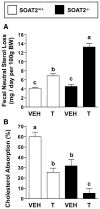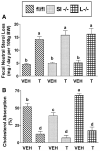Sterol O-Acyltransferase 2-Driven Cholesterol Esterification Opposes Liver X Receptor-Stimulated Fecal Neutral Sterol Loss
- PMID: 26729489
- PMCID: PMC5221701
- DOI: 10.1007/s11745-015-4116-7
Sterol O-Acyltransferase 2-Driven Cholesterol Esterification Opposes Liver X Receptor-Stimulated Fecal Neutral Sterol Loss
Abstract
Statin drugs have proven a successful and relatively safe therapy for the treatment of atherosclerotic cardiovascular disease (CVD). However, even with the substantial low-density lipoprotein (LDL) cholesterol lowering achieved with statin treatment, CVD remains the top cause of death in developed countries. Selective inhibitors of the cholesterol esterifying enzyme sterol-O acyltransferase 2 (SOAT2) hold great promise as effective CVD therapeutics. In mouse models, previous work has demonstrated that either antisense oligonucleotide (ASO) or small molecule inhibitors of SOAT2 can effectively reduce CVD progression, and even promote regression of established CVD. Although it is well known that SOAT2-driven cholesterol esterification can alter both the packaging and retention of atherogenic apoB-containing lipoproteins, here we set out to determine whether SOAT2-driven cholesterol esterification can also impact basal and liver X receptor (LXR)-stimulated fecal neutral sterol loss. These studies demonstrate that SOAT2 is a negative regulator of LXR-stimulated fecal neutral sterol loss in mice.
Keywords: Atherosclerosis; Cholesterol; Esterification; Intestine.
Figures




References
-
- Roger VL, Go AS, Lloyd-Jones DM, Adams RJ, Berry JD, Brown TM, Carnethon MR, Dai S, de Simone G, Ford ES, Fox CS, Fullerton HJ, Gillespie C, Greenlund KJ, Hailpern SM, Heit JA, Ho PM, Howard VJ, Kissela BM, Kittner SJ, Lackland DT, Lichtman JH, Lisabeth LD, Makuc DM, Marcus GM, Marelli A, Matchar DB, McDermott MM, Meigs JB, Moy CS, Mozaffarian D, Mussolino ME, Nichol G, Paynter NP, Rosamond WD, Sorlie PD, Stafford RS, Turan TN, Turner MB, Wong ND, Wylie-Rosett J. Heart disease and stroke statistics—2011 update: a report from the American Heart Association. Circulation. 2011;123:e240. - PMC - PubMed
-
- Third report of the National Cholesterol Education Program (NCEP) expert panel on detection, evaluation, and treatment of high blood cholesterol in adults (Adult Treatment Panel III) final report. Circulation. 2002;106:3143–3421. - PubMed
-
- Rudel LL, Lee RG, Parini P. ACAT2 is a target for treatment of coronary heart disease associated with hypercholesterolemia. Arterioscler Thromb Vasc Biol. 2005;25:1112–1118. - PubMed
-
- Rudel LL, Farese RV., Jr ACAT inhibition and the progression of coronary atherosclerosis. N Engl J Med. 2006;354:2616–2617. - PubMed
-
- Oshiro T, Tomoda H. Acyltransferase inhibitors: a patent review (2010-present) Expert Opin Ther Pat. 2015;25:145158. - PubMed
Publication types
MeSH terms
Substances
Grants and funding
LinkOut - more resources
Full Text Sources
Other Literature Sources
Medical
Miscellaneous

